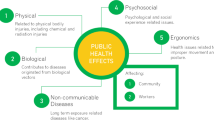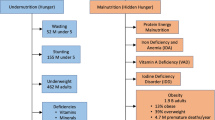Abstract
This study was aimed to provide, by mapping the spatial distribution of hair selenium levels of residents, visualized evidence for assessment of KD elimination from a perspective of selenium nutrition of the residents living in the KD-endemic and non-endemic areas. Using a spatial ecological research design, 401 male permanent residents in KD-endemic and non-endemic areas participated in this study. Demographic information and hair samples were obtained through a questionnaire survey and sample collection, respectively. Hair selenium was measured using hydride generation atomic fluorescence spectrometry. Thematic maps were created, and spatial analysis was conducted using ArcGIS 9.0. The median of hair selenium of the participants was 0.30 (IQR, 0.23-0.34) mg/kg. The median hair selenium of the residents in the KD-endemic areas was significantly lower than that of the residents of the non-endemic areas. The hair selenium levels of residents were spatially clustered, with cold spots and hot spots located in northwest and southwest regions respectively. Residents living in KD-endemic areas may still have selenium deficiency. Measuring hair selenium levels of residents in KD-endemic areas as a molecular marker of selenium nutritional status as part of KD surveillance could provide visualized evidence for the evaluation of KD elimination from a perspective of selenium nutrition of the residents living in the KD endemic areas.




Similar content being viewed by others
Data Availability
Not applicable.
Code Availability
Not applicable.
References
Guangsheng L, Fan W, Deren K, Cai L (1985) Keshan disease: an endemic cardiomyopathy in China. Hum Pathol 16(6):602–609. https://doi.org/10.1016/s0046-8177(85)80110-6
Ge K, Yang G (1993) The epidemiology of selenium deficiency in the etiological study of endemic diseases in China. Am J Clin Nutr 57(2 Suppl):259S–263S. https://doi.org/10.1093/ajcn/57.2.259S
Li Q, Liu M, Hou J, Jiang C, Li S, Wang T (2013) The prevalence of Keshan disease in China. Int J Cardiol 168(2):1121–1126. https://doi.org/10.1016/j.ijcard.2012.11.046
Wang T (2015) Assessment of Keshan disease elimination: the challenges and opportunities. Chin J Endemiol 34(006):391–392 (in Chinese)
The Special Three-year Action Plan for Prevention and Control of Endemic Disease from 2018 to 2020, China. (2018) National Health Commission of the People’s Republic of China. http://www.cpad.gov.cn/art/2018/12/20/art_50_92201.html. Accessed 28 August 2020
Yang GQ, Chen JS, Wen ZM, Ge KY, Zhu LZ, Chen XC, Chen XS (1984) The role of selenium in Keshan disease. Adv Nutr Res 6:203–231. https://doi.org/10.1007/978-1-4613-2801-8_8
Xu GL, Wang SC, Gu BQ, Yang YX, Song HB, Xue WL, Liang WS, Zhang PY (1997) Further investigation on the role of selenium deficiency in the aetiology and pathogenesis of Keshan disease. Biomed Environ Sci 10(2-3):316–326
Gao J, Liu Y, Huang Y, Lin ZQ, Banuelos GS, Lam HW, Yin X (2011) Daily selenium intake in a moderate selenium deficiency area of Suzhou, China. Food Chem 126(3):1088–1093. https://doi.org/10.1016/j.foodchem.2010.11.137
Liu H, Yu F, Shao W, Ding D, Yu Z, Chen F, Geng D, Tan X, Lammi MJ, Guo X (2018) Associations between selenium content in hair and Kashin-Beck disease/Keshan disease in children in northwestern China: a prospective cohort study. Biol Trace Elem Res 184(1):16–23. https://doi.org/10.1007/s12011-017-1169-x
The questionnaire for Prevention and Control of Keshan Disease, China (2017) National Health Commission of the People’s Republic of China. http://210.46.80.45/crcfedc/jck.html. Accessed 28 August 2020
Hou J, Wang T, Liu M, Li S, Chen J, Liu C, Zhang H, Wang Y, Liu Z, Liang N, Wan Y, Li Q, Sun S, Zhang L, Feng H, Liu Y, Wang H (2011) Suboptimal selenium supply--a continuing problem in Keshan disease areas in Heilongjiang province. Biol Trace Elem Res 143(3):1255–1263. https://doi.org/10.1007/s12011-011-8961-9
Zhang X, Wang T, Li S, Ye C, Hou J, Li Q, Liang H, Zhou H, Guo Z, Han X (2018) A spatial ecological study of selenoprotein P and Keshan disease. J Trace Elem Med Biol 51:150–158. https://doi.org/10.1016/j.jtemb.2018.10.011
Zhang X, Wang T, Li S, Ye C, Hou J, Li Q, Liang H, Zhou H, Guo Z, Han X, Wang Z, Wu H, Gao X, Xu C, Zhen R, Chen X, Duan Y, Wang Y, Han S (2019) A spatial ecology study of Keshan disease and hair selenium. Biol Trace Elem Res 189(2):370–378. https://doi.org/10.1007/s12011-018-1495-7
Sun L, Cui S, Deng Q, Liu H, Cao Y, Wang S, Yu J (2019) Selenium content and/or T-2 toxin contamination of cereals, soil, and children’s hair in some areas of Heilongjiang and Gansu Provinces, China. Biol Trace Elem Res 191:294–299. https://doi.org/10.1007/s12011-018-1620-7
Delimitation and Classification of Keshan disease areas (GB17020-2010), China. (2010) The Ministry of Health of the People’s Republic of China. http://www.nhc.gov.cn/wjw/s9500/wsbz_2.shtml. Accessed 28 August 2020
Heilongjiang Statistical Yearbook, China (2019) Heilongjiang Bureau of Statistics. http://tjj.hlj.gov.cn/tjsj/tjnj/. Accessed 28 August 2020
Sumei L, Gary BU, Longhua W, Weiming S (2014) The changing selenium nutritional status of Chinese residents. Nutrients 6(3):1103–1114. https://doi.org/10.3390/nu6031103
Skalny AV, Burtseva TI, Salnikova EV, Ajsuvakova OP, Skalnaya MG, Kirichuk AA, Tinkov AA (2019) Geographic variation of environmental, food, and human hair selenium content in an industrial region of Russia. Environ Res 171:293–301. https://doi.org/10.1016/j.envres.2019.01.038
Ngigi PB, Laing GD, Masinde PW, Lachat C (2020) Selenium deficiency risk in central Kenya highlands: an assessment from the soil to the body. Environ Geochem Health 42(7):2233–2250. https://doi.org/10.1007/s10653-019-00494-1
Dos Santos M, Penteado JO, Baisch PRM, Soares BM, Muccillo-Baisch AL, da Silva Júnior FMR (2021) Selenium dietary intake, urinary excretion, and toxicity symptoms among children from a coal mining area in Brazil. Environ Geochem Health 43(1):65–75. https://doi.org/10.1007/s10653-020-00672-6
Tinkov AA, Skalnaya MG, Ajsuvakova OP, Serebryansky EP, Chao JC-J, Aschner M, Skalny AV (2020) Selenium, zinc, chromium, and vanadium levels in serum, hair, and urine samples of obese adults assessed by inductively coupled plasma mass spectrometry. Biol Trace Elem Res (prepublish) 199:490–499. https://doi.org/10.1007/s12011-020-02177-w
Yang J, Wang T, Wu C, Liu C (2010) Selenium level surveillance for the year 2007 of Keshan disease in endemic areas and analysis on surveillance results between 2003 and 2007. Biol Trace Elem Res 138(1-3):53–59. https://doi.org/10.1007/s12011-010-8609-1
Li H, Yang L, Tan J, Wang W, Hou S, Li Y, Yu J, Wei B (2017) Progress on selenium deficiency in geographical environment and its health impacts in China. Curr Biotechnol 007(005):381–386 (in Chinese)
Evaluation Methods for Control and Elimination of Key Endemic diseases, China (2018) National Health Commission of the People’s Republic of China. http://www.nhc.gov.cn/jkj/s5873/201908/b0ac881a9c5348e0aa3763fa2bc98d43.shtml. Accessed 28 August 2020
(1979) Observations on effect of sodium selenite in prevention of Keshan disease. Chin Med J 92(7):471–476
Chen X, Yang G, Chen J, Chen X, Ge K (1980) Studies on the relations of selenium and Keshan disease. Biol Trace Elem Res 2(2):91–107. https://doi.org/10.1007/BF02798589
Zhou H, Wang T, Li Q, Li D (2018) Prevention of Keshan disease by selenium supplementation: a systematic review and meta-analysis. Biol Trace Elem Res 186:98–105. https://doi.org/10.1007/s12011-018-1302-5
Xu L, Yanan W, Shan H, Yiyi Z, Yuanjie Z, Shengqi S, Huihui Z, Xiao Z, Hong L, Jie H, Tong W (2020) A spatial ecological study on serum selenium and Keshan disease in Heilongjiang Province, China. Biol Trace Elem Res. https://doi.org/10.1007/s12011-020-02478-0
Li D, Wang T, Feng H, Zhang L (2019) Overview of Keshan disease surveillance and trend analysis in China. Chin J Endemiol 038(005):385–389 (in Chinese)
Wang T (2012) The translation epidemiology of Keshan disease surveillance. Foreign Med Sci (Section of Medgeography) 33(3):143–147 (in Chinese)
Hira CK, Partal K, Dhillon KS (2004) Dietary selenium intake by men and women in high and low selenium areas of Punjab. Public Health Nutr 7(1):39–43. https://doi.org/10.1079/phn2003513
Chawla R, Filippini T, Loomba R, Cilloni S, Dhillon KS, Vinceti M (2020) Exposure to a high selenium environment in Punjab, India: biomarkers and health conditions. Sci Total Environ 719:134541.134541–134541.134514. https://doi.org/10.1016/j.scitotenv.2019.134541
Loomba R, Filippini T, Chawla R, Chaudhary R, Cilloni S, Datt C, Singh S, Dhillon KS, Vinceti M (2020) Exposure to a high selenium environment in Punjab, India: effects on blood chemistry. Sci Total Environ 716:135347.135341–135347.135315. https://doi.org/10.1016/j.scitotenv.2019.135347
Funding
This study was funded by the National Natural Science Foundation of China (no. 81773368).
Author information
Authors and Affiliations
Contributions
Designed the research, TW; Conducted the research and collected the data, XL, YW, SH, YYZ, SS, HZ, XZ, HL, YJ, LQ, YW and RW; Analyzed the data, YZ and XL; Thematic map production, YZ and XL; Wrote the manuscript, TW and YZ. All authors have read and agreed to the published version of the manuscript.
Corresponding author
Ethics declarations
Conflict of Interest
The authors declare that they have no conflict of interest.
Ethics Approval
The research protocol was approved by the review committee of the Ethics Committee of Harbin Medical University.
Consent to Participate
All participants provided written informed consent.
Consent for Publication
Not applicable.
Additional information
Publisher’s Note
Springer Nature remains neutral with regard to jurisdictional claims in published maps and institutional affiliations.
Rights and permissions
About this article
Cite this article
Zou, Y., Liu, X., Wang, T. et al. A Spatial Ecological Study on Hair Selenium Level of Residents in Keshan Disease Endemic and Non-endemic Areas in Heilongjiang Province, China. Biol Trace Elem Res 199, 4546–4554 (2021). https://doi.org/10.1007/s12011-021-02609-1
Received:
Accepted:
Published:
Issue Date:
DOI: https://doi.org/10.1007/s12011-021-02609-1




